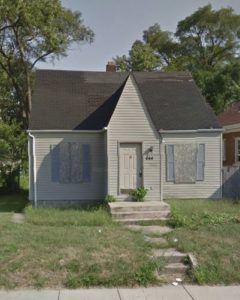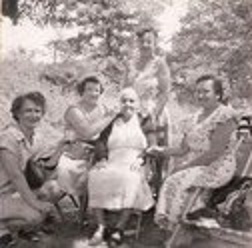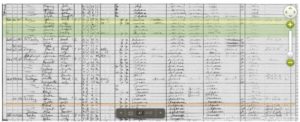
I’ve been researching a mystery man, Anton “Tony” Kos, who was buried in 1934 next to my great grandfather, Joseph Koss, in Oak Hill Cemetery in Gary, Indiana. You can see from the above pic I took in December 2001 how close the stones are compared to the next stone to the right. Looks to me like the plot was one.
I never got a straight answer regarding how Tony and Joseph are related, if at all. I’d love to find out if they were related, which I strongly think is possible, and why my mother and grandmother refused to verify that.
Here’s what I know…I used to accompany my mom and grandma to the family cemetery around Memorial Day to tend to the graves. We’d always go to the old part of the cemetery first, to clip the grass around the gravestone of my great grandfather, Joseph Kos[s] who died in 1919 during the Spanish flu pandemic. When I was old enough to read, I noticed that next to his grave was an Anton Kos. I knew the family name was originally spelled with one “s” but I had never heard of Anton so I asked how he was related and never got an answer. I recall my mother just looking at my grandmother and my grandmother looking down and continuing to tidy up her father’s grave. So, as only a small child will do, I asked again. I never got a straight answer. I tried several other times over the years and got various answers; that Kos is a very common Croatian name like Smith is in Great Britain. That didn’t tell me if Tony was related. It also didn’t explain why I never saw another grave in the cemetery with the original spelling of the surname. When I asked about that, I got, “I don’t know why.” as a response. (There actually is another Kos, John, who died in 1934 buried in the cemetery but as a child, I had never seen that grave.)
I tentatively placed Anton as a sibling of my great grandfather Joseph. Joseph was born in 1875 and Anton, in 1879. I had called the cemetery in 2012 to ask who purchased Anton’s plot and was told that no one did because the cemetery records don’t have an Anton Kos. I told the clerk I knew where he was buried, immediately south of my great grandfather. They insisted no one was buried there. Looking at the records, I understand what happened. Anton is listed as Tony in cemetery records, even though Anton is chiseled on his tombstone. Tony was what was recorded on his death certificate and the cemetery must have listed him under that name. My great grandfather’s tombstone has his Americanized name, Joseph Kos and not his birth name, Josip Kos so there was another possible clue that my family was involved. These folks Americanized as soon as they arrived in 1910.
As an adult, I can see another family trait that gives credence to a relationship; my family plans for their deaths. I could see that they would have purchased two plots when my great grandfather died in 1919 expecting that his wife would be buried next to him. But she lived on until 1966. I’m thinking when a family member who was in need of the plot died, the family buried him instead. My family always helped out a relative in need, be it sending care packages back across the pond, fronting them money or taking them into their home for awhile. My grandparents had purchased a larger plot in the newer section of the cemetery that was the intended burial site for them and my great grandmother. It is also where I buried my mother’s cremains.
After we tidied the old section (but we never touched Anton’s stone, which is interesting), we’d move to the new section to trim the grass around the Koss stone. No one was yet buried there but my forward thinking grandparents had enough sense to purchase the stone while they were still employed. (And thanks, mom, for taking care of your end of life stuff prior to your death. Hope our kids appreciate we did the same – yes, you can already find me on Find-A-Grave.)
So getting no where with the cemetery, I decided to try to research Anton Anthony Tony to find a connection.
From Ancestry.com, you can see his death certificate below:

No help with his parents info but it does say he was born in “Yugo Slavia” just like Joseph Koss. He also died of lung issues, just like Joseph. Joseph’s whole family had lung issues, hmm. Not a smoking gun but certainly gives one pause to consider a relationship as they all died young. He also was a laborer in a steel mill, though not the same one where Joseph worked. Granted, most immigrants at the time were laborers and steel mills offered good wages.
I have never been able to find Tony in any census – having checked 1920-1940 under Anton, Anthony and Tony Kos, Koss and Ross (as my own people have been enumerated as).
There is another mystery – who was Steve Sesta who provided the death certificate info? I’ve never heard of him.
The death certificate gives me a clue to look at the address where Tony was living when he died, 35 East 39th Street, Gary, Indiana.
So here’s a tip – I want to use the 1940 census to find who was living at Tony’s address. It could take quite some time using Ancestry.com because I would need to click on every enumeration area and Gary was a large city so there are many. To save time, I used the National Archives site (just Google 1940 U.S. Federal Census enumeration map and you’ll be taken directly to it or use my link).
Since I grew up in the city, I know the layout of the street and avenue names, which saved me time. If you are researching an area you aren’t familiar with, simply use Google earth to get a better idea. In my case, I knew that streets ran north and south, avenues ran east and west. Street names west of Broadway used the president’s names in order (Washington, Adams, Jefferson, no repeat of Adams, etc.) and east of Broadway used states’ names, in no particular order. So, I was looking for 39th Street and could eliminate all of the western side of Broadway simply by identifying if the first page of the census had a presidents name or not.
After going through 3 enumeration areas, I found the address:
The address was divided into two housing units, front and rear. Steve, who had provided the death certificate info, lived in the rear. That means Tony was living in the front but he wasn’t there in 1940. It also explains why there is no parent information for Tony, neighbor Steve did not know that information. (I know, you’re thinking I should check property records to see who owned the residence but the problem is most of Gary’s records were “lost” according to the Lake County, Indiana property appraiser’s office. I suspect they’re somewhere in Gary and just weren’t turned over to the county when the law changed but I don’t live anywhere close to be able to hunt around for them so that’s a dead end for me.)
The death certificate did state Tony had worked for 1 year as a laborer for Illinois Steel. He may have only arrived in the area in 1942, during World War II.
I checked immigration records but there are many Anton Kos’ who emigrated from Austria-Hungary/Yugoslavia so I’m unable to pinpoint one of them as my mystery man.
I know, from a recent DNA match with another relative, that during World War II, my Cvetkovic relatives were displaced to another part of what is now Croatia, due to mayhem in the area where the family originally resided in Velika Gorica. It certainly is possible that Tony had left the area because of the war and came to the U.S. to a place where family already resided.
Tony was survived by a wife, Anna, who was born in 1878. Perhaps she remarried as she is not listed in cemetery records by the last name Kos or Koss or like Tony, she wasn’t entered in the cemetery database correctly. Unfortunately, only 30% of the cemetery is listed on Find-A-Grave. There’s nothing on Billion Graves either.
Somehow, I have a maiden name for her as Smolkovic but I have no idea where I got that info. I also have a marriage date, but no place, and two children residing in Rhode Island. That info was obtained years ago before I carefully sourced (shame on me!). This is an area I need to further research.
I checked City Directories and there is only one Anthony in Gary but he was married to a Mary living on Filmore Street in Gary in 1918. He never appears in any other directory. My Kos line doesn’t arrive in Gary until 1919 so I suspect he wasn’t the my Tony. There is no Tony or Anton ever in any City Directory for Gary. I got his obituary thanks to the Ask-A-Librarian link on the Lake County library site but it provides basically no information other than he had died after a long illness, which disputes the information on the death certificate. Or, maybe not. Perhaps he suffered from lung problems for years but the incident that caused his death had been short.
There is no one in my family much older than me left who would know – definitely no one who was alive in 1943 that would remember. Decided I’d try the cemetery again since it’s recently been sold and maybe the new owners have done an inventory of grave sites. Sent an email on Sunday and haven’t gotten a response so will follow up with a phone call this week.
If that falls through, I’m going to attempt to check Baptism records for Velika Gorica to see if I can link Anton to Joseph’s parents. Unfortunately, they aren’t on Familysearch.org so I’ll have to email a genealogist in Croatia to do some digging.
Connecting Tony and Joseph would be awesome but I’ll most likely never get the story of why he was not discussed since dead men tell no tales!















